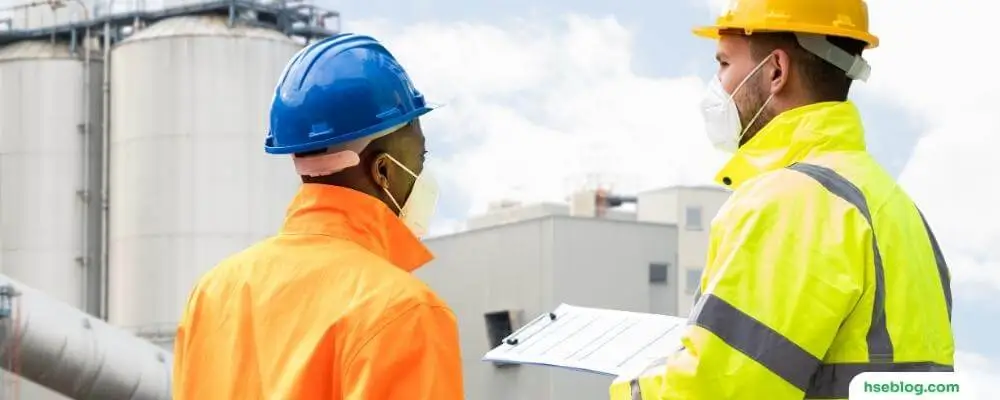Maintaining a safe and healthy work environment is critical to the success of any organization. By law, employers are responsible for ensuring their employees’ health and safety in the workplace. However, achieving this goal requires more than just fulfilling legal requirements. It requires collaboration between workers and employers to identify potential hazards, develop effective solutions, and implement strategies to mitigate risks.
This blog will explore the ten benefits of combined worker and employer involvement in health and safety consultation. We will examine how this collaborative approach can enhance workplace safety, reduce costs, increase employee satisfaction, and ultimately contribute to the success of your organization. Whether you are an employer or an employee, understanding the importance of health and safety consultation can make a significant difference in your workplace. So, let’s dive in and explore the benefits of this approach in greater detail.
10 Benefits Of Combined Worker And Employer Involvement In Health and Safety Consultation
Health and safety in the workplace are crucial considerations for any organization, as it is essential to ensure the well-being of workers and prevent accidents and injuries. One of the key ways that organizations can promote health and safety is through consultation between workers and employers. Organizations can benefit from their insights and expertise by involving workers in health and safety discussions and decision-making, leading to more effective policies and practices.
1. Improved Workplace Safety
Involving workers in health and safety discussions and decision-making allows organizations to tap into the knowledge and expertise of their employees. Workers directly involved in the work processes are often more aware of their jobs’ potential hazards and risks. Organizations can identify potential hazards and risks by consulting workers, such as unsafe equipment, improper work practices, or hazardous substances, and develop effective strategies to address them.
When workers are actively involved in identifying and addressing workplace hazards, they are more likely to take ownership of the solutions and become more vigilant in identifying potential risks in the future. This can lead to a safer workplace environment, reducing the likelihood of accidents and injuries.
Overall, involving workers in health and safety discussions and decision-making can lead to a more proactive and effective approach to workplace safety, resulting in a safer work environment for all employees.

2. Increased Worker Satisfaction
Involving workers in health and safety discussions and decision-making can also positively impact worker satisfaction. When workers feel that their opinions and input are valued and respected, they are likelier to feel engaged and motivated. They may also feel more invested in the success of the organization and its safety culture.
A workplace prioritizing worker health and safety can also lead to a greater sense of job security and trust between workers and management. This can increase job satisfaction and a stronger commitment to the organization’s goals.
In addition, when workers feel that their safety is a priority, they may experience less stress and anxiety related to their work. This can lead to a better work-life balance and positively impact their well-being. Overall, involving workers in health and safety consultation can increase worker satisfaction, motivation, and engagement, resulting in a more productive and positive workplace culture.
3. Enhanced Communication
Effective communication is a crucial aspect of promoting health and safety in the workplace. Involving workers in health and safety discussions and decision-making can help to improve communication between workers and employers, leading to a better understanding of each other’s perspectives and priorities.
Workers can provide valuable feedback on the effectiveness of existing health and safety policies and practices and suggest improvements or modifications enhance their safety and well-being. This feedback can help employers to identify potential issues and address them before they become accidents.
On the other hand, employers can also communicate their reasoning behind health and safety decisions, ensuring that workers understand the importance of certain policies and practices. This can help build trust and foster a positive workplace culture where workers feel their input is valued and respected.
Overall, enhanced communication resulting from health and safety consultation between workers and employers can help to promote a safer and more productive workplace culture. It can also lead to increased trust, engagement, and collaboration between workers and management, resulting in better overall outcomes for the organization.

4. Increased Trust
Trust is a critical component of any successful workplace. Workers who feel that their employers prioritize their safety and well-being are more likely to trust their employers and management team. This can improve relationships between workers and employers, leading to a positive workplace culture.
By involving workers in health and safety discussions and decision-making, employers demonstrate their commitment to worker safety and well-being. Workers involved in these discussions and decisions feel their opinions and perspectives are valued and respected, leading to a stronger sense of trust and respect towards their employers.
A workplace culture prioritizes safety and values worker input can also lead to greater job satisfaction, motivation, and engagement. Workers who feel valued and respected are more likely to be committed to their jobs, leading to improved productivity and better retention rates.
Overall, increased trust resulting from health and safety consultation can positively impact workplace culture, improving relationships between workers and employers, greater job satisfaction, and increased productivity.
5. Improved Compliance
Ensuring compliance with health and safety policies and regulations is essential for any organization to promote a safe and healthy workplace. Organizations can increase compliance with these policies and regulations by involving workers in health and safety discussions and decision-making.
When workers are involved in developing and implementing health and safety policies and procedures, they are more likely to understand the reasoning behind them and feel that their input has been considered. This can result in increased worker buy-in, leading to improved compliance with health and safety policies and procedures.
Furthermore, workers actively identifying and addressing workplace hazards are more likely to be aware of potential hazards. This increased awareness can lead to a greater understanding of the importance of complying with health and safety policies and procedures and a greater commitment to following them.
Overall, improved compliance resulting from health and safety consultation can lead to a safer and healthier workplace environment, reducing the likelihood of accidents and injuries. It can also help organizations to avoid potential legal and financial consequences associated with non-compliance with health and safety policies and regulations.

6. Reduced Costs
Effective health and safety practices can help to reduce the costs associated with accidents and injuries in the workplace. By involving workers in health and safety consultation, organizations can identify potential hazards and risks and develop strategies to address them, leading to a safer and more cost-effective workplace.
Accidents and injuries can result in direct costs such as medical expenses, workers’ compensation claims, and legal fees. They can also result in indirect costs such as lost productivity, increased absenteeism, and decreased worker morale.
By implementing effective health and safety practices and involving workers in developing these practices, organizations can identify and address potential hazards and risks, leading to a safer work environment and reducing the likelihood of accidents and injuries. This can result in significant cost savings for organizations, both in terms of direct costs, such as medical expenses, and indirect costs, such as lost productivity.
In addition, effective health and safety practices can also result in lower insurance premiums, as insurers often offer lower premiums to organizations with robust health and safety policies and procedures in place.
Overall, reduced health and safety consultation costs can lead to a more cost-effective workplace environment, reducing the financial burden associated with accidents and injuries and improving the organization’s overall financial health.
7. Improved Innovation
Involving workers in health and safety discussions and decision-making can also lead to improved innovation in the workplace. Workers directly involved in the work processes often have insights and expertise that can be leveraged to identify innovative solutions to health and safety challenges.
Workers may have ideas for innovative solutions to address potential hazards and risks, such as new equipment or processes or new ways of managing existing hazards. By consulting with workers and incorporating their ideas into health and safety policies and procedures, organizations can identify and implement more effective and efficient solutions to health and safety challenges.
Furthermore, involving workers in health and safety consultation can also lead to greater ownership and responsibility for health and safety issues. Workers who are invested in the success of their organization’s health and safety practices are more likely to take a proactive approach to identify and address potential hazards and risks, leading to improved innovation in the workplace.
Overall, improved innovation resulting from health and safety consultation can lead to more effective policies and procedures, reducing the likelihood of accidents and injuries and creating a safer and healthier workplace environment. It can also result in improved productivity, increased efficiency, and greater cost savings for the organization.

8. Increased Efficiency
Effective health and safety practices can also lead to increased efficiency in the workplace. By involving workers in health and safety consultation, organizations can identify potential hazards and risks and develop strategies to address them before they become accidents. This can result in a more efficient workplace, as workers are less likely to experience injuries or illnesses that can result in lost productivity and increased costs.
In addition, effective health and safety practices can also result in a more organized and streamlined workplace environment. Health and safety policies and procedures can help to establish clear guidelines and expectations for workers, reducing the likelihood of confusion and misunderstandings. This can result in a more efficient workflow, as workers can complete tasks more quickly and effectively.
Overall, increased efficiency resulting from health and safety consultation can improve productivity, reduce costs, and create a more streamlined work environment. By identifying potential hazards and risks and implementing effective solutions to address them, organizations can create a safer and more efficient workplace for all employees.
9. Improved Reputation
Effective health and safety practices can also positively impact an organization’s reputation. By involving workers in health and safety consultation, organizations can demonstrate their commitment to the well-being of their workers, which can enhance their reputation as responsible and ethical employers.
A strong reputation for health and safety can also attract new customers, investors, and employees who value workplace safety and well-being. This can improve business outcomes, as organizations prioritizing health and safety are more likely to be perceived as trustworthy and reliable.
Furthermore, organizations with a strong reputation for health and safety may also benefit from reduced insurance premiums, as insurers often offer lower premiums to organizations with robust health and safety policies and procedures.
Overall, an improved health and safety consultation reputation can positively impact an organization’s bottom line, enhancing its brand image, attracting new customers, investors, and employees, and reducing insurance costs.

10. Increased Compliance With Social Responsibility
Effective health and safety practices can help organizations comply with their social responsibility obligations. By involving workers in health and safety consultation, organizations can demonstrate their commitment to the well-being of their workers and their community, which can help to build trust and loyalty among stakeholders.
Organizations have a social responsibility to ensure that their activities do not harm the health and safety of their workers or the environment. By implementing effective health and safety practices and involving workers in health and safety consultation, organizations can demonstrate their commitment to fulfilling this obligation.
Furthermore, organizations prioritizing health and safety are more likely to be perceived as socially responsible by stakeholders such as customers, investors, and the general public. This can enhance their reputation and improve their relationships with these stakeholders, increasing loyalty and support.
Overall, increased compliance with social responsibility resulting from health and safety consultation can lead to a more positive impact on society, a stronger reputation, and improved stakeholder relationships. It can also help organizations to fulfill their social responsibility obligations and create a safer and healthier workplace environment.
Conclusion
Involving workers in health and safety consultation can bring numerous benefits to organizations, including improved workplace safety, increased worker satisfaction, enhanced communication, increased trust, improved compliance, reduced costs, innovation, efficiency, reputation, and compliance with social responsibility obligations.
By involving workers in health and safety discussions and decision-making, organizations can tap into the knowledge and expertise of their employees, identify potential hazards and risks, and develop effective strategies to address them. This can lead to a safer and more productive workplace environment, improving workers’ well-being and enhancing the organization’s overall success.
Health and safety consultation is essential to promoting a positive workplace culture and fulfilling an organization’s social responsibility obligations. By prioritizing health and safety and involving workers in these efforts, organizations can create a safer, more productive, and socially responsible work environment for all employees.

